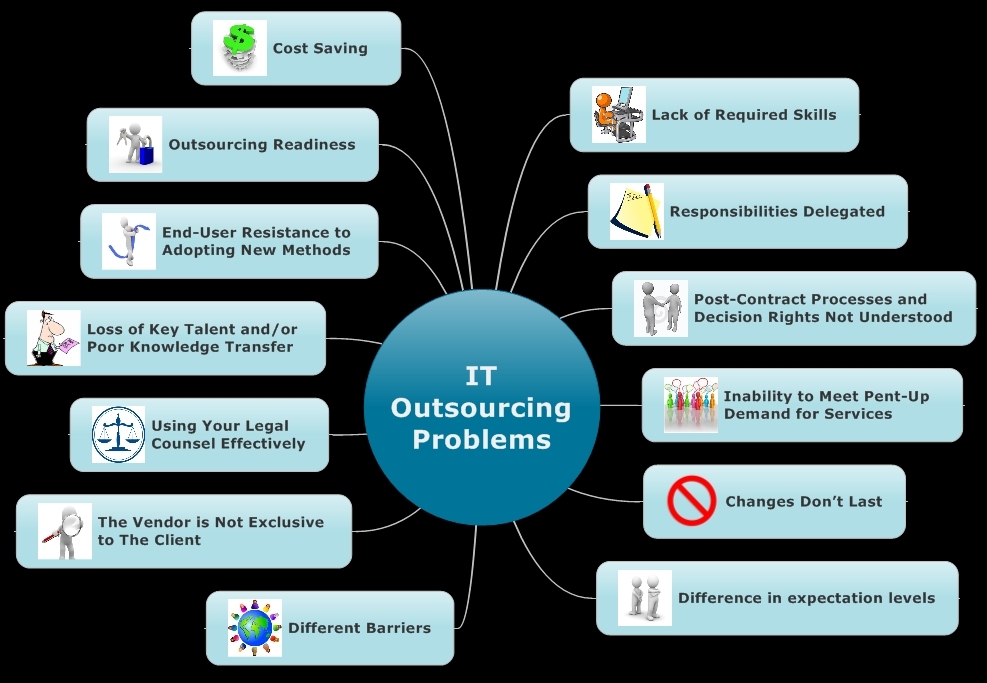


While outsourcing IT functions seems attractive in terms of cost savings and other efficiencies, it is not easy to take the right decisions leading to fruitful results. It is absolutely essential for a company to look at all the variables of outsourcing before making the decision to use it as a tool for growth. Here are a number of possible outsourcing problems that you may come:

1. Outsourcing Readiness. Is your company ready to outsource? First, clients need to realize that the reference for proposal, proposal and negotiation process is very time consuming and expensive for all parties involved, including outsourcers. Second, many clients do not consider that the intelligent negotiation of an outsourcing deal requires that they gather and provide to the vendor extensive, validated internal data. Validation is important.
2. Cost Saving. To choose the right company, cost saving shouldn’t be the sole priority of the firm looking to outsource part of its work. The reason is that although services would be available fairly cheaply irrespective of the domain, the quality suffers badly. Besides, you need to be wary of some hidden costs of outsourcing that are usually skipped by some negotiators. Always inquire about the legal costs of signing contracts and time to spend on contract coordinating.
3. Lack of Required Skills. With many outsourcing implementations, there is an outright lack of a defined retained/governance team or one that is too small. Even if a client puts a retained team in place to manage the outsourcing implementation and ongoing operations, the team may not have the right skills required for their new roles.
4. Responsibilities Delegated. Another problem with outsourcing of any kind today is what responsibilities are being outsourced. Many companies end up outsourcing crucial core company functions, like accounting and even secretarial services.
5. Post-Contract Processes and Decision Rights Not Understood. Clients and service providers are not operationally prepared to work together after contract signing. The results are that services simply aren’t performed, implementation activities get stalled, client stakeholders and service provider staff are both frustrated, and the entire schedule for achieving expected business benefits is delayed.
6. Inability to Meet Pent-Up Demand for Services. Prior to an outsourcing implementation, the client organization also may curtail big projects and non-essential spending. If the client has limited these activities, there is typically a substantial amount of pent-up demand and/or requirements that need to be met shortly after the implementation period begins.
7. Difference in expectation levels. Often the expectation levels could be very different between the clients and the vendors. A client might need to have checkpoints at various stages to see if the vendor’s output is in line with the expectations and justifies the initial cost and investment.
8. Different Barriers. Such as time zone differences, language barriers, unexpected cultural differences, and the necessity for data security are all areas that could make your off shoring more of a hassle than your financial savings are worth.
9. The Vendor is Not Exclusive to The Client. It might make the client jittery if the vendor also has relationship with the competitors. This leads to lack of trust which is very much essential for a project to be successful.
10. Using Your Legal Counsel Effectively. Remember that experienced outsourcing legal counsel have seen over the years what works and what doesn’t work in the structuring, selection and negotiation phases of outsourcing. Your lawyer will be most effective when viewed as part of the overall outsourcing team and involved in discussions and decisions in each phase.
11. Loss of Key Talent and/or Poor Knowledge Transfer. Outsourcing creates uncertainty for existing employees and contractors who provide services to the client organization. The uncertainty can cause this staff to look elsewhere for employment and leave either before or during the outsourcing implementation.
12. End-User Resistance to Adopting New Methods. The provider is not in complete control of the end-to-end result. The users on the receiving end of new methods can inhibit the achievement of business objectives through lack of compliance, strategy disagreements or delays in executing their required responsibilities.
13. Changes Don’t Last. Old habits die hard. Even for organizations that initially change behaviors and processes to achieve success with outsourcing, there can be a significant tendency to revert to old ways of doing things.

